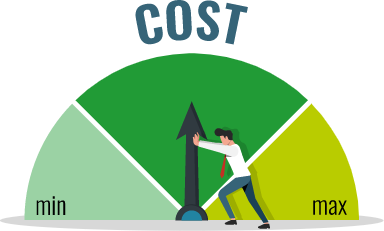DevOps Certification Training Course in India
Passion driven instructors who believe in practical teaching


DevOps Training
DevOps training will help you to get DevOps real time experience on how to use the most common DevOps patterns to develop, deploy, and maintain applications on AWS. It also evaluates you on the core principles of the DevOps methodology. The DevOps methodology gives you a complete view of the entire software development process and allows for continuous delivery and deployment of new software. Applying the DevOps methodology to your workflow will expedite the rate at which you develop, launch, and support new software by reducing the systems development lifecycle SDLC DevOps of a new product
DevOps Overview
A DevOps engineer introduces processes, tools, and methodologies to balance needs throughout the software development life cycle, from coding and deployment to maintenance and updates.
Maybe you want to shift your career to DevOps or train yourself to drive adoption within your company. But how do you become a DevOps engineer? Start training today!
What does a DevOps engineer do?
An AWS engineer is an IT professional who creates, maintains, and evolves an AWS cloud infrastructure for running applications. These infrastructures include production, test, and development environments. Now that we’ve established a definition of the job, we need to get into more detailed specifics of precisely what they do.
Be responsible for the planning, implementation, and growth of the AWS cloud infrastructure. Build, release, and manage the configuration of all production systems.
Manage a continuous integration and deployment methodology for server-based technologies. Work alongside architecture and engineering teams to design and implement any scalable software services. Ensure necessary system security by using best in class cloud security solutions. Stay current with new technology options and vendor products, evaluating which ones would be a good fit for the company
Implement continuous integration/continuous delivery (CI/CD) pipelines when necessary. Recommend process and architecture improvements
Troubleshoot the system and solve problems across all platform and application domains. Oversee pre-production acceptance testing to ensure the high quality of a company’s services and products

Tools to Master
Best DevOps Tools to Learn and Docker, Jenkins, Maven, Chef, Puppet, Ansible, Docker, Nagios, Kubernetes, Git, Gradle, Jira Software and Saltstack






Why DevOps is been the Popular choice of in the IT Industry?

It is an easy and reliable workflow

Quality and performance of Software where Improved

It Reduces the overall operational cost.
AWS Training Syllabus
- DevOps Principles in detail
- DevOps Engineer Skills in the marketKnowing DevOps Delivery Pipeline
- Market trend of DevOps
- DevOps Technical Challenges
- Tools we use in DevOps
- Knowing about Version control
- Git – A CLI
- Essentials of GIT in industry
- How to setup GIT
- Installing Git
- First-Time Git Setup
- Getting a Git Repository
- Working with various commands in GIT
- Recording Changes to the Repository
- How to check the Status of Your Files
- How to track New Files
- Staging our modified files
- Ignoring Files from GIT
- Viewing Your Unstaged and Staged Changes
- How to commit Your Changes
- Skipping the Staging Area and commit
- Removing Files from GIT
- Viewing the Commit History
- Limiting Log Output
- Using a GUI to Visualize History
- Undoing Things
- Changing Your Last Commit
- Unstaging a Staged File
- Unmodifying a Modified File
- Working with Remotes
- Showing Your Remotes
- Adding Remote Repositories
- Fetching and Pulling from Your Remotes
- Pushing to Your Remotes
- Inspecting a Remote
- Removing and Renaming Remotes
- Branching and Merging in Git
- What a Branch Is
- Basic in Branching and Merging
- Branch Management in GIT
- Branching Workflows and its usage
- Remote Branches – create and delete
- Rebasing
- Git workflows
- Git cheat sheet
- Essentials of Continuous Integration
- An example scenario where CI is used
- Know about Jenkins and its architecture in detail
- Jenkins tool Management in detail
- Installing Jenkins
- Post-installation setup wizard
- Unlocking Jenkins
- Customizing Jenkins with plugins
- Creating the first administrator user
- Know about User management in Jenkins
- Authentication
- Jenkins own database user creation
- Options to enable integration with LDAP
- Authorization
- Matrix based authorization
- Project based authorization
- Overview of Maven
- Maven project structure
- Maven plugins
- Project Object Model (POM) – fundamental unit of work in Maven project
- Maven build lifecycle
- Adding external dependencies to maven pom.xml
- Maven build and test project
- Creating jobs and automatic build settings
- What is Jenkins Pipeline?
- Why Pipeline?
- Integration with GIT
- How to enable project based authorization for a job
- Source code management while creating jobs
- Triggering automated build
- Maven job setup
- Know about post build options for jobs like notifications, trigger another build, publishing reports, etc.
- Adding a slave node to Jenkins
- Building Delivery Pipeline
- Notification settings in Jenkins
- Plugin management in Jenkins
- Introduction
- Real-world Shipping Transportation Challenges
- Introducing Docker and its technology
- Understanding of Docker images and containers
- Working with container
- How to Share and copy a container
- Container Life Cycle
- How to use Base Image and customize
- Creation of Docker File
- How to Publish Image on Docker Hub
- Introduction to Docker Networking
- Network Types in docker technology
- Docker Container Networking
- Docker Compose – An introduction
- Docker Swarm – An introduction
- Use Docker Compose to create php, WordPress, MySQL
- How to Start Containers on a Cluster with Docker Swarm
- Creating and Scaling an application in Docker swarm
- Introducing Ansible – A configuration management tool
- Basics / What Will Be Installed
- Understanding Ansible architecture
- Control Machine Requirements
- Managed Node Requirements
- Inventory
- Hosts and Groups
- Host Variables
- Group Variables
- Learn various ansible Modules
- How to use adhoc commands
- Parallelism and Shell Commands
- File Transfer
- Managing Packages
- Users and Groups
- Deploying From Source Control
- Managing Services
- Introduction to YAML script
- Playbook o About Playbooks
- Playbook Language Example – YAML
- How to Write Playbooks
- Tasks in Playbooks
- Understanding about various tasks in playbook
- Introduction to Handlers and variables
- Learn about using handlers, variables in the playbook
- Become (Privilege Escalation)
- Roles
- Role Directory Structure
- Using Roles
- Role Duplication and Execution
- Role Default Variables
- Role Dependencies
- Role Search Path
- Ansible Galaxy
- Including and Importing
- Includes vs. Imports
- Importing Playbooks
- Including and Importing Task Files
- Including and Importing Roles
- Writing a playbook to install and configure webservers and deplo0y an application
- How to create Ansible Role and use it
- Using an ansible role in playbook
- How to use Ansible Galaxy to download roles.
- Example – Install and use Jenkins roles from ansible galaxy
- Essentials of Cloud computing?
- Cloud and virtualization architecture
- Cloud deployment architecture
- Cloud providers – An overview
- Why we need DevOps on Cloud?
- Introducing to Amazon web services
- Various AWS services for DevOps – An overview
- DevOps using AWS – Demo
DevOps Salary In India:
Fresher:
₹6,43,000 Avg.Base Salary (INR)
Experienced:
₹22, 43,000

